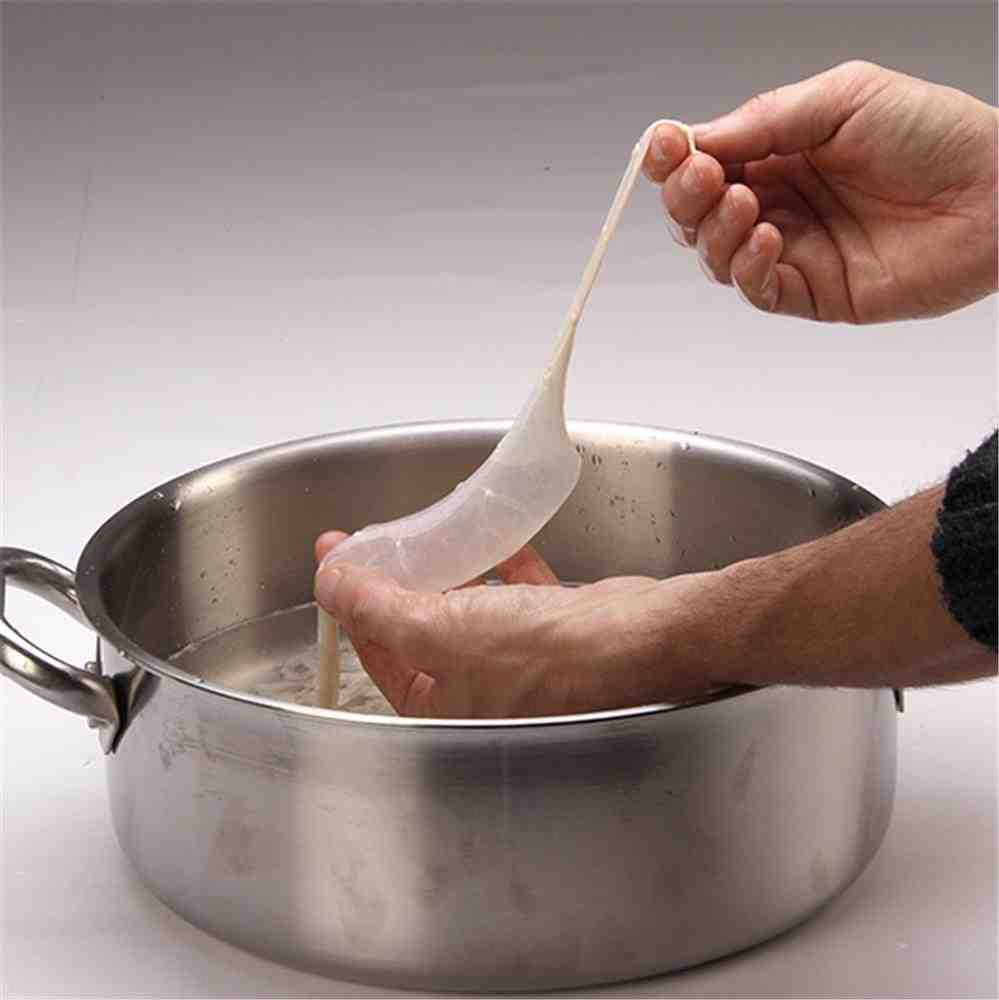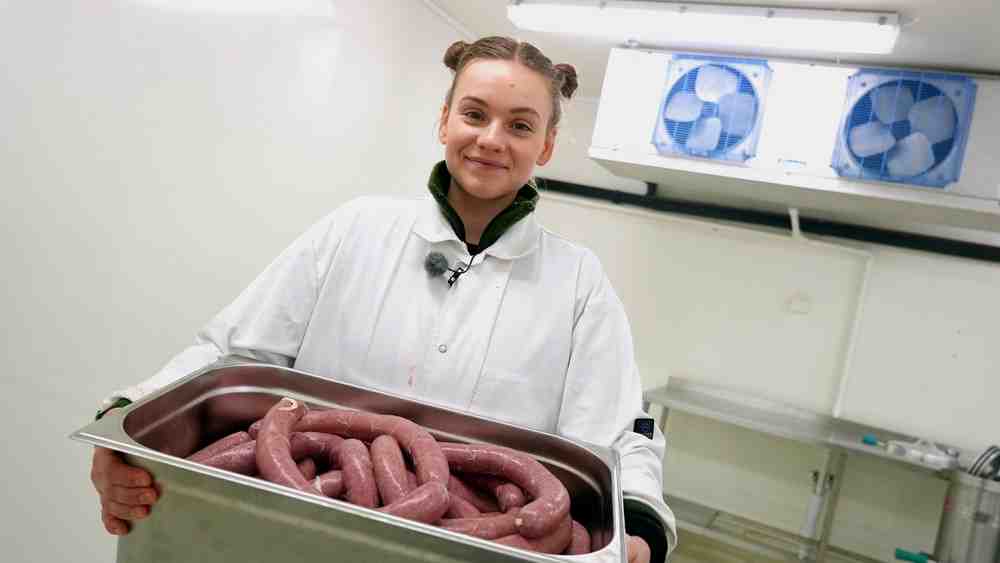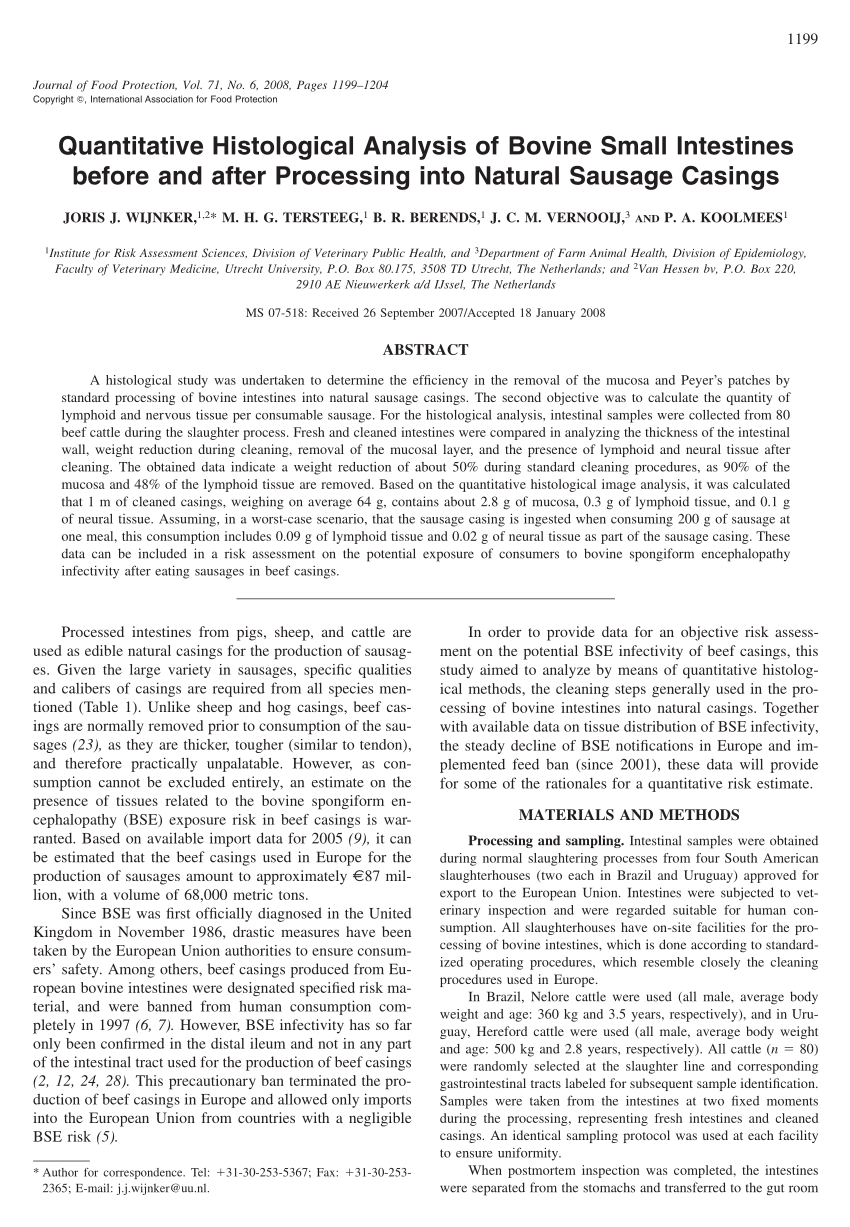Pork, water, salt, spices, dextrose, sugar, sweet yeast, lemon powder (corn syrup, concentrated lemon juice, natural aroma), salty taste (natural aroma, maltodextrin), natural aromas, citric acid , lactic acid.
Are sausages made from pig intestines?

The most popular sausage casings are made with cleaned intestines from animals, especially pigs, sheep and cows. These are called â € œnatural gutâ € and the most ubiquitous is the 32-34 mm pork gut. To see also : What has been found in hot dogs?. This is the gut that is used for sausages as a bratwurst.
Do Butchers Still Use Intestines for Sausages? 03 / 5â € ‹The traditional natural casing of sausages has changed a lot over the years and so has the production of natural casings; Currently, the natural intestines are made up of the submucosa, a layer (consisting of natural collagen) of animal intestine and this is what gives the sausage a shiny appearance.
Are sausage made with intestines?
Information. In general, “natural” sausage casings are made from the submucosa of the intestines of meat animals (beef, sheep and pork). To see also : Are hot dogs made out of pig snouts?.
Can you eat sausage casing?
Sausage casings are used to hold and shape the filling inside so that it can be cooked. There are natural sausage casings and synthetic varieties, and most are edible. While most sausage lovers will cook a sausage in their gut, there are times when the gut can be removed.
Are sausage casings made of plastic?
Synthetic casings Artificial sausage casings can be made from materials such as collagen, cellulose and plastic and may not always be edible. Collagen guts have been around for a long time and are made from animal collagen, mainly from cow and pig skins.
Do they still use pig intestine for sausages?
The large intestines of pork are also used for preparations such as chitterlings or stuffing meat. Read also : Is there plastic in hot dogs?. In the elaboration of sausages they are used to stuff sausages of liver, some salamis, etc.
Do they still use intestines for hot dogs?
When cellulose casings are used, hot dogs are of exact size and weight. They are vacuum sealed in plastic wrap to protect the freshness and flavor of the hot dog. Because the guts of natural guts are made from the intestines of cleaned and processed animals, they are similar in size, but not exact.
What are Woolworths sausages made of?

Australian meat (beef and lamb) (73%), water, rice flour, corn flour, potato starch, salt, mineral salts (450,451, 452), hydrolyzed vegetable proteins (corn), vegetable powder (onion, garlic), vegetable powder (onion, garlic), preservative (223), sugar, seasoning, spice extract (including red pepper oleoresins), natural …
How sausages are made disgusting?

What are disgusting sausages made of? Sausages must have a suitable natural casing made with casings. Commercially produced sausage can have all kinds of animal parts and parts added, so possibly dirty! and the carcass is usually made artificially of cellulose and collagen, so it still looks like the gut, but it still disgusts me.
What part of the pig is in a sausage?
Pork Shoulder (Picnic Shoulder) Another hard cut, pork shoulder (also called a picnic shoulder) is often cured or smoked. Pork shoulder is also used to make ground or sausage pork.
What parts are sausages made of?
A sausage is a type of meat product usually made from ground meat, often pork, beef or poultry, along with salt, spices and other flavors. Other ingredients such as grains or breadcrumbs may be included as fillers or spreaders.
What part of the animal is in a sausage?
Traditionally, a sausage casing is made from animal gut, but can sometimes be made of plastic. There are many forms of sausages, such as hot dogs, pepperoni, bologna and salami. Sausages often have meat on the head, lips, cheeks, ears and other parts of the animal. Some have blood.
What are sausages really made of?
Most sausages are made with pork, but can be made with almost any animal. The real secret behind making a delicious sausage is the addition of lard. A) Because it is delicious and adds flavor. B) Because it transforms the texture of ground meat into a soft, moist product.
What’s really in a sausage?
At its core, a sausage is simply ground meat and fat, salt and spices. It’s really not much more complicated than grinding your own burger; you don’t even have to enter it in links if you don’t want to.
Do sausages still use intestines?
Traditionally, link sausage is wrapped in natural casings made from animal casings, but there are also artificial casings available on the market. Today, most commercial sausages use synthetic casings.
How hotdogs are made nasty?
The next part of the hotdog trip is probably the most disgusting. Sprinkle water over the whole meat mixture while baptizing in a tub and add corn syrup for a little sweetness. In images that may make you want to vomit, the pureed meat is squeezed through a tube that sucks in air.
Are hot dogs made out of lips and Buttholes?
A recent study by Canadian pathologists set out to find out if the sad legend is true. The good news is that hot dogs do not appear to be made of “oral and anal scaly mucosa,” as it is known in medical parlance. The bad news is that the real ingredients of hot dogs are not rated much better.
Are hotdogs made of pig Buttholes?
In fact, almost every hot dog in the United States is made with meat alone. “
What are sausages made out of?

Most sausages are made with pork, but can be made with almost any animal. The real secret behind making a delicious sausage is the addition of lard. A) Because it is delicious and adds flavor. B) Because it transforms the texture of ground meat into a soft, moist product.
What are Australian sausages made of? What are the parts of a sausage? In Australia, we have regulations stating that at least half of all sausage content should include lean meat. This can come from any part of any animal, but it is mainly scraps (or scraps of premium cuts such as rump or leaf) of pork, beef or veal.
What part of the animal is sausage made from?
Traditionally, a sausage casing is made from animal gut, but can sometimes be made of plastic. There are many forms of sausages, such as hot dogs, pepperoni, bologna and salami. Sausages often have meat on the head, lips, cheeks, ears and other parts of the animal. Some have blood.
What part of the cow is sausage?
Beef chuck is the cut of beef that most commonly becomes ground beef for making sausages (and burgers). It comes from the animal’s shoulders and is very affordable. Beef chuck has a fat content of 15-20%, ideal because it prevents the sausage from drying out.
What is sausage made up of?
Introduction. Sausage is usually defined as a mixture of ground meat, combined with spices and condiments. Sausage is often stuffed into some kind of casing and bonded, but there are also loose sausage products. Originally, sausage was made as a means of recovering the value of cuts and cuts of lesser value meat.
Which part of the pig is sausage?
Pork shoulder is taken from the top of the pork shoulder, it is quite hard and is usually sold as a boneless roast. Pork ribs also come from this area and are cut with bones. Meat from this area is also used for ground and sausage pork.
What all meats come from a pig?
There are five sections of pork that give edible cuts: pork shoulder, pork belly, pork loin, pork ass (or ham) and head. From these sections, the butcher can offer sausage, bacon, rib, rib, ribs, fillets, pork chops, pork chops, coppa, prey, secret and fillet.
What meats are considered pork?
Here’s a brief guide to primary pork cuts.
- Pork Butt (or Boston Butt) His name is misleading. …
- Picnic shoulder. Also known as pig’s shoulder, the picnic shoulder comes from under the pig’s butt. …
- Pork loin. …
- Ham. …
- Pork meat. …
- Spare rib. …
- Pork belly. …
- Pig foot.
What are sausage skins made out of?

Sausage casing, also known as sausage skin or simply tripe, is the material that closes the filling of a sausage. Natural guts are made of the gut or skin of animals; artificial guts, introduced in the early twentieth century, are made of collagen and cellulose.
Do they still use pork gut for sausages? The large intestines of pork are also used for preparations such as chitterlings or stuffing meat. In the elaboration of sausages they are used to stuff sausages of liver, some salamis, etc.
Are sausage casings made of plastic?
Synthetic casings Artificial sausage casings can be made from materials such as collagen, cellulose and plastic and may not always be edible. Collagen guts have been around for a long time and are made from animal collagen, mainly from cow and pig skins.
Are sausage casing safe to eat?
Sausage casings are used to hold and shape the filling inside so that it can be cooked. There are natural sausage casings and synthetic varieties, and most are edible. While most sausage lovers will cook a sausage in their gut, there are times when the gut can be removed.
What are sausage casings made of today?
Natural casings The most popular casings for sausages are made from the cleaned intestines of animals, especially pigs, sheep and cows. These are called â € œnatural gutâ € and the most ubiquitous is the 32-34 mm pork gut. This is the gut that is used for sausages as a bratwurst.
Is the plastic on sausages edible?
What are sausage casings? Sausage casings are used to hold and shape the filling inside so that it can be cooked. There are natural sausage casings and synthetic varieties, and most are edible.
Are you supposed to take the film off of sausage?
Do not cut the sausage. The cut should be light but large enough to show the tearing of the carcass on the sides. Use your thumbs, start rolling the loose carcass, and gently pull it out of the meat. If the meat sticks to the carcass, return the sausage links to the freezer for another 10 minutes.
Do sausages have plastic around them?
These are usually the most available sausages that you devour from time to time, but did you know that they can have traces of synthetic substances? Yes, there are three types of artificial sausage casing that are usually made with collagen, cellulose, and plastic, which may not be completely edible.
What is sausage skin made of?
Natural guts. Natural sausage casings are made from the submucosa of the small intestine, a layer of the intestine that consists of natural collagen. The use of this type of casing dates back centuries, is one of the oldest ways of making sausages, a classic of the sausage tradition.
Can you eat sausage casing?
Sausage casings are used to hold and shape the filling inside so that it can be cooked. There are natural sausage casings and synthetic varieties, and most are edible. While most sausage lovers will cook a sausage in their gut, there are times when the gut can be removed.
What is sausage skin made of UK?
* Natural sausage skins are made from pork, sheep or cow gut. Imitation skins are made of collagen, often cowhide.
What is bologna made out of?
Meat: The main ingredient in Bologna is ground meat, which can be any combination of pork, beef, chicken and turkey or just one of these meats. You can even find bolognese made from deer or other game meats.
What parts of animals is Bologna made of? Bologna uses some of the least desirable pieces of meat While mortadella typically uses pork back and cheek meat, Bologna makeup consists of what is known as “raw skeletal muscle” and other by-products of raw meat. , such as the heart, kidney, or liver of a pig.
Is bologna healthy to eat?
4. Processed meat for lunch. Lunch meats, including sausages, bologna and ham, make up the unhealthy list because they contain a lot of sodium and sometimes fat, as well as some preservatives such as nitrites.
What is the healthiest lunch meat?
Fresh meat still has sodium because it is used for preservation, so look for options that say low in sodium to help reduce salt. Choose the leanest cut of meat possible, such as turkey, chicken breast, lean ham, or roast beef. These types of sausages have the highest nutritional value compared to others.
What is the healthiest bologna to eat?
US Wellness Meats’ Beef Bologna is a one-pound roll of flavored grass-fed beef. It is also free of nitrates, nitrites, MSG, additives, preservatives, soy, dairy and gluten. It is perfect for a healthy snack, a light lunch or a road trip.
What are the ingredients of bologna?
Mechanically separated meats (chicken and / or turkey and / or pork), pork and / or beef and / or bacon; water, modified corn starch, salt, soy protein isolate, potassium lactate, sugar, spices (contains mustard), sodium phosphate, sodium erythorbate, monosodium glutamate, sodium diacetate, sodium nitrite, smoke aroma , rock …
What are 3 ingredients used in the making of the bologna?
How to make homemade bologna. Start simple, using ingredients you can pick up at any grocery store: meat, garlic powder, onion powder, liquid smoke, salt, and a little brown sugar if you like. As for the equipment, you can get away with a food processor, but a stand mixer is even easier.
Is bologna made of horse meat?
Bologna is a cooked and smoked sausage made from cured beef, cured pork or a mixture of the two. Bolognese can include selected cuts, depending on who is making it, but it usually contains later reflections from the meat industry: organs, garnishes, final pieces, and so on.
How can you tell if meat is horse meat?
Horse meat varies in color. The meat of younger horses has a lighter color and flavor, while the meat of older horses has a deeper color and flavor. Horse meat is usually lean and relatively tender. Older horses are considered to have the tenderest meat, different from a cow’s calf.
What deli meat has horse meat?
Horse steak is widely available in restaurants. A smoked and marinated meat specialty known as Mostbröckli is made here with beef or horse meat. Horse meat is also used for a variety of German-speaking sausages in northern Switzerland.
Sources :
